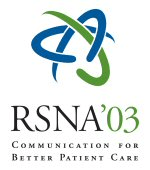
Abstract Archives of the RSNA, 2003
Aurea Mohana-Borges MD, PRESENTER: Nothing to Disclose
Abstract:
HTML
Purpose: The purpose of this study was to explore the relative distribution of the locations of full-thickness (FT) RC tears as seen by MR imaging in a surgically confirmed cohort of patients.
Methods and Materials: Records of eighty-two consecutive patients who underwent arthroscopic surgery of the shoulder over a 2-year period and a preceding MR imaging examination at the same institution were reviewed. Of these, forty-four patients (all men, age range 33-83 years, mean age 58) with FT (30 patients) or partial-thickness (PT) tears (14 patients) of either the supraspinatus (SS) or infraspinatus (IS) tendons were selected for the study. Two musculoskeletal radiologists, blinded to arthroscopic results, independently reviewed the MR images and analyzed the following parameters: presence or absence of RC tear, extent (FT or PT) of RC tears, and sites of FT RC tears (insertion site versus critical zone). Interobserver agreement was calculated using kappa statistics.
Results: The mean accuracy for the diagnosis of FT SS and IS tears was, respectively, 85% and 89%. In most of cases, misdiagnosis was due to incorrect distinction between SS FT and high-grade PT lesions. In the group of true-positive SS tears (30 patients), the insertion site was abnormal in 24 patients (80%) for reader 1, in 25 patients (83%) for reader 2, and in 25 patients (83%) in the consensus analyses. In 7 cases, disagreements were associated with tears close to the junction of the insertion site and the critical zone (N=4), tears with severe retraction and abnormality of the tendon stumps (N=2), and oblique tears extending to both the insertion site and the critical zone (N=1). In the group of true positive IS tears (10 patients), the insertion site was considered abnormal in 9 patients (90%) for both readers and in all patients (100%) in the consensus analysis. In 2 cases, disagreements were associated with a tear close to the junction of the insertion site and the critical zone (N=1), and a tear not identified by one of the readers (N=1). The interobserver agreement for distribution of tears was 0.38 (suboptimal) for the SS tendon and 0.76 (good) for the IS tendon. The low interobserver agreement for the SS tendon was due to the low frequency of critical zone cases and the lack of agreement between readers for those few cases. No statistical significance was identified for patient's age and site of RC tear.
Conclusion: In contrast to the current concept of the high frequency of RC tears occurring in the critical zone, the majority of FT tears of the RC are located at the humeral insertion site of the tendons.
Questions about this event email: mohanaborges70@hotmail.com
Mohana-Borges MD, A,
Location of Rotator Cuff Tears: MR Imaging Study --How Critical is the Critical Zone?. Radiological Society of North America 2003 Scientific Assembly and Annual Meeting, November 30 - December 5, 2003 ,Chicago IL.
http://archive.rsna.org/2003/3107833.html

